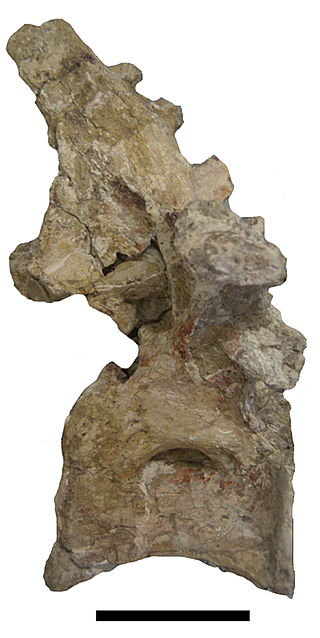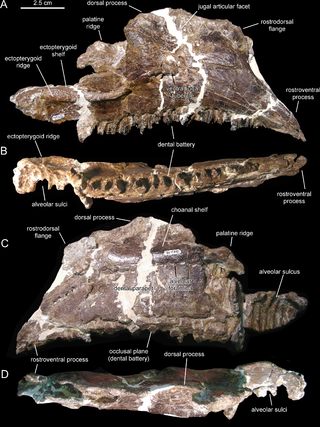
Titanosaurs were a diverse group of sauropod dinosaurs, including genera from all seven continents. The titanosaurs were the last surviving group of long-necked sauropods, with taxa still thriving at the time of the extinction event at the end of the Cretaceous. This group includes some of the largest land animals known to have ever existed, such as Patagotitan—estimated at 37 m (121 ft) long with a weight of 69 tonnes —and the comparably-sized Argentinosaurus and Puertasaurus from the same region.

Ampelosaurus is a titanosaurian sauropod dinosaur from the Late Cretaceous Period of what is now France. Its type species is A. atacis, named by Le Loeuff in 1995. Its remains were found in a level dating from 71.5 million years ago representing the early Maastrichtian.

Epachthosaurus was a genus of titanosaurian sauropod dinosaur from the Late Cretaceous. It was a basal lithostrotian titanosaur. Its fossils have been found in Central and Northern Patagonia in South America.

Lirainosaurus is a genus of titanosaur sauropod which lived in what is now Spain. The type species, Lirainosaurus astibiae, was described by Sanz, Powell, Le Loeuff, Martinez, and Pereda-Suberbiola in 1999. It was a relatively small sauropod, measuring 4 metres (13 ft) long, possibly up to 6 metres (20 ft) long for the largest individuals, and weighed about 2–4 metric tons.
Argiles et Grès à Reptiles Formation also known as the Argiles Rutilantes Formation is an early Maastrichtian French geologic formation in the département of Var preserving the remains of several types of dinosaurs and other extinct organisms.

Lithostrotia is a clade of derived titanosaur sauropods that lived during the Early Cretaceous and Late Cretaceous. The group was defined by Upchurch et al. in 2004 as the most recent common ancestor of Malawisaurus and Saltasaurus and all the descendants of that ancestor. Lithostrotia is derived from the Ancient Greek lithostros, meaning "inlaid with stones", referring to the fact that many known lithostrotians are preserved with osteoderms. However, osteoderms are not a distinguishing feature of the group, as the two noted by Unchurch et al. include caudal vertebrae with strongly concave front faces (procoely), although the farthest vertebrae are not procoelous.
The Marnes d’Auzas Formation is a geological Formation in southwestern France whose strata date back to the Late Maastrichtian. It is about 100 metres thick and consists primarily of marls with some interbeds of sandstones. It corresponds to sediments whose depositional environment evolved from the paralic domain at the base of the formation, towards a more continental domain in its upper part. The Marnes d’Auzas Formation was deposited in the west coast of the former Ibero-Armorican Island, which included much of France and Spain.

The Villalba de la Sierra Formation is a Campanian to Maastrichtian geologic formation in Spain. Fossil dinosaur eggs have been reported from the formation, that comprises gypsiferous, grey, argillaceous mudstones and sandstones, deposited in a floodplain environment characterised by high seasonality and variability in water availability.

Opisthocoelicaudiinae is a subfamily of titanosaurian dinosaurs from the Late Cretaceous. It was named by John McIntosh in 1990. Opisthocoelicaudiines are known from Mongolia, Argentina, and the United States. Two genera were assigned to Opisthocoelicaudiinae by Gonzalez et al. (2009): Alamosaurus and Opisthocoelicaudia, a conclusion also found by Díez Díaz et al. (2018). The hands of opisthocoelicaudiines lacked wrist bones and phalanges.

Atsinganosaurus is a genus of titanosaurian sauropod dinosaur which existed in what is now France during the Late Cretaceous. Well-preserved remains of Atsinganosaurus were collected from the Grès à Reptiles Formation of the Aix-en-Provence Basin. The type and only species is A. velauciensis.

Canardia is an extinct genus of lambeosaurine dinosaur known from the Late Cretaceous Marnes d'Auzas Formation of Haute-Garonne department, in Occitanie region, southwestern France. The type species Canardia garonnensis was first described and named by Albert Prieto-Márquez, Fabio M. Dalla Vecchia, Rodrigo Gaete and Àngel Galobart in 2013. It is only known from juvenile specimens. The name of the genus comes from “canard”, the French word for “duck”, an allusion to the fact that this animal belongs to the hadrosaurids which are also known as duck-billed dinosaurs. The specific epithet garonnensis refers to the Haute-Garonne department where this dinosaur has been found. Although universally recognized as a lambeosaurine, its precise position within them is debated. Some authors consider it as a close relative of the genus Aralosaurus from Central Asia with which it would form the tribe Aralosaurini, while others include it in a more derived clade, the Arenysaurini in which all lambeosaurines from Europe and North Africa are placed. Canardia was one of the last non-avian dinosaurs and lived between 67,5 and 66 my on the former Ibero-Armorican Island, which included much of France and Spain.

Eutitanosauria is a clade of titanosaurs, encompassing the more derived members of the group and characterized by the absence of the hyposphene-hypantrum articulation and possibly the presence of osteoderms. The group was first named by Sanz and colleagues in 1999, who used it to unite the group of Argyrosaurus, Lirainosaurus, Saltasaurus and the Peiropolis titanosaur. However, this definition was not used as it made the group equivalent to Saltasauridae, so Saldago redefined it in 2003 to be all titanosaurs closer to Saltasaurus than Epachthosaurus. This definition created Eutitanosauria as the sister group to Epachthosaurinae, but was problematic due to the variable nature of Epachthosaurus. Eutitanosauria was often broadly similar to Lithostrotia, and has often been unused or unlabelled on phylogenies. Sometimes Epachthosaurus would be more primitive than Malawisaurus, making Eutitanosauria more encompassing than Lithostrotia, or Epachthosaurus could nest close to Colossosauria and limit Eutitanosauria to a smaller group of saltasauroids. Because of the flexible nature of Epachthosaurus in basal titanosaur phylogeny, Carballido and colleagues redefined the group in 2022 to include the smallest clade of both Patagotitan, a colossosaur, and Saltasaurus, creating a node-stem clade with Colossosauria and Saltasauroidea, presenting the informal cladogram of stable titanosaur clades below.
Lohuecotitan is an extinct genus of titanosaurian sauropod dinosaur which lived during the Late Cretaceous in Spain. The only species known in the genus is Lohuecotitan pandafilandi, described and named in 2016.

Saltasaurini is a tribe of titanosaur sauropods known from the Late Cretaceous of Patagonia, Argentina. The clade was named in 2007 by Leonardo Salgado and José Bonaparte as the "least inclusive clade comprising Neuquensaurus and Saltasaurus", which is equivalent to the use of Saltasaurinae in Salgado et al. (1997). Found only in the Campanian to Maastrichtian sediments of the Neuquén Basin, Salgado & Bonaparte (2007) decided a more restrictive clade was needed because of the expansion of Saltasaurinae as defined to include far more taxa than it originally encompassed. Saltasaurini includes the original core of Saltasaurinae: Neuquensaurus, Saltasaurus, Rocasaurus and Bonatitan, although some studies exclude Bonatitan from the clade.
Garrigatitan is a genus of titanosaurian dinosaur from the late Cretaceous Period of the Grès à Reptiles Formation in France. The genus contains a single species, Garrigatitan meridionalis.

Saltasauroidea is a superfamily of titanosaurs named by França and colleagues in 2016 based on their phylogenetic results, for a clade uniting Aeolosaurini and Saltasauridae, as well as the intermediate genera Baurutitan, Diamantinasaurus and Isisaurus. The group was not defined or discussed in the text, but was supported by Carballido and colleagues in 2022 as a useful designation for subdividing titanosaurs. As there was no discussion about the intentions for the clade, Carballido gave it the definition of all taxa closer to Saltasaurus than Patagotitan, encompassing half of Eutitanosauria as the sister taxon to the inversely defined Colossosauria. Carballido et al. placed Nemegtosauridae and Saltasauridae within the group, though they had Aeolosaurini within Colossosauria. The informal cladogram of titanosaur relationships they proposed is shown below.

Abditosaurus is an extinct genus of titanosaurian sauropod dinosaur from the Late Cretaceous (Maastrichtian) Tremp Group of Catalonia, Spain. The type and only species is Abditosaurus kuehnei. Phylogenetic analyses recover it within a clade of South American and African saltasaurines, distinct from other insular dwarf sauropods from the European archipelago. Abditosaurus inhabited the Ibero-Armorican Island, a prehistoric island made up of what is now Spain, Portugal, and southern France, and would have been the largest titanosaur species in its environment.
Ibirania is a genus of dwarf saltasaurine titanosaur dinosaur from the Late Cretaceous São José do Rio Preto Formation of Southeast Brazil. The type species is Ibirania parva. It is one of the smallest sauropods known to date, comparable in size to the titanosaur Magyarosaurus.
Udelartitan is an extinct genus of saltasauroid titanosaurian sauropod dinosaur from the Late Cretaceous Guichón Formation of Uruguay. The genus contains a single species, U. celeste, known from fragmentary remains of at least two individuals.























